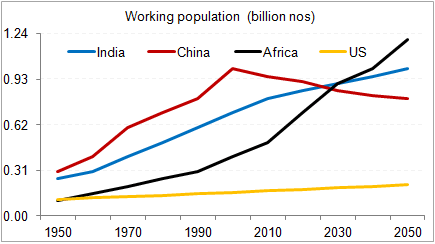Indian Polity
Utilising the Demographic Dividend of India
This article is based on India’s population data and a tale of two projections which was published in The Hindu on 15/07/2020. This article discusses the Demographic dividend of India and needed policies and measures to reap its benefits.
A new study, recently published by Seattle-based Institute for Health Metrics and Evaluation (IHME) predicts that India will be the most populated country in the world. Its population will peak by 2050 by reaching 1.64 billion and thereafter it will decline to 1.09 billion by 2100.
On the contrary, the United Nations Development Programme (UNDP) projects that India’s population will be 1.64 billion by 2050. The UNDP predicts a population of 1.45 billion by 2100 instead of 1.09 billion by the IHME.
Despite the mismatch between UN’s projections and the IHME projections, India’s population will surely peak and subsequently decline in population, driven by a sharp reduction in fertility.
However, irrespective of how the population grows there is a narrow window of time, in which India has to leverage this demographic dividend. Thus, adequate measures and policies should be effectively implemented to utilise this opportunity and stop turning demographic dividend into demographic disaster.
Demographic Dividend of India
- India's population is among the youngest in an ageing world. By 2022, the median age in India will be 28 years; in comparison, it will be 37 in China and the United States, 45 in western Europe, and 49 in Japan.
- India’s working-age population has numerically outstripped its non-working age population.
- A demographic dividend, said to have commenced around 2004-05, is available for close to five decades.
Challenges with Demographic Dividend
- Disparity in periods of window of demographic dividend: Since, India’s population is heterogeneous, the window of demographic dividend becomes available at different times in different States.
- While Kerala’s population is already ageing, in Bihar the working age cohort is predicted to continue increasing till 2051.
- By 2031, the overall size of our vast working age population would have declined in 11 of the 22 major States.
- Need for skills: The Economic Survey 2019 highlights the gap between the projected annual increase in working age population and the available number of jobs.
- Further, UNICEF 2019 reports that at least 47% of Indian youth dont have the adequate education and skills necessary for employment in 2030.
- Gender Imparity: Growing female literacy is not translating into relevant and marketable skills.
- Lack of flexible entry and exit policies for women into virtual classrooms, and into modules for open digital training, and vocational education limits access to contemporary vocations.
Utilisation of the Demographic Dividend
- Improving education infrastructure: The projected demographic dividend would turn into a demographic disaster if an unskilled, under-utilised, and the young population undermines social harmony and economic growth.
- While over 95% of India’s children attend primary school, the National Family Health Surveys (2015-16) confirm that poor infrastructure in government schools, malnutrition, and scarcity of trained teachers have resulted in poor learning outcomes.
- Balancing equity and quality in education: While India aspires to become a knowledge economy, millions of young people are getting left behind.
- High quality education could achieve gender parity and propels people forward into more productive lives.
- Ensuring universal accessibility to education: Most districts now have excellent broadband connectivity.
- Irrespective of rural or urban setting, the public school system must ensure that every child completes high school education, and is pushed into appropriate skilling, training and vocational education in line with market demand.
- Modernising school curricula: Systematically investing in teacher training is required so that they grow in their jobs to assume leadership roles, while moving beyond the limits of the syllabus.
- Deploying new technology in education: To accelerate the pace of building human capital, virtual classrooms together with massive open online courses (MOOCS) can be instrumental to help prepare this huge workforce for next-generation jobs.
- Investing in open digital universities would further help yield a higher educated workforce.
- Improving health care: In India, population health is caught between the rising demand for health services and competition for scarce resources.
- The National Sample Survey Office data on health 2018, shows that a downturn in the rural economy is making quality health-care unaffordable.
- People are availing of private hospitals less than they used to, and are moving towards public health systems.
- The Ayushman Bharat Yojana links demand to tertiary in-patient care. This promotes earnings of under-utilised private hospitals, instead of modernising and up-grading public health systems in each district.
- Also, 70% of health sector budgets should be assigned to integrate and strengthen primary and integrated public health-care services and systems up to district hospital levels.
- Women emancipation: A comprehensive approach is needed to improve their prospects of gainful employment. This could include:
- Starting adequate job portals and organisations to provide employment for trained women, even from home.
- Guaranteeing equal pay for women will make it worth their while to stay longer in the workforce.
Conclusion
If India wants to leverage the economic potential of its youth bulge, then it must invest in improving social infrastructure viz. good health, quality education, and endeavour to provide decent employment to their entire population.
These policies and their effective implementation will ensure that demographic dividend, which is a time-limited opportunity, becomes a boon for India.
|
Drishti Mains Question “The demographic dividend holds the key to India becoming a superpower” Critically Analyse. |
This editorial is based on “After the harvest” published in Indian Express on August 11th, 2020. Watch this on our Youtube channel now.





